26
SepGrab Deal : Upto 30% off on live classes + 2 free self-paced courses - SCHEDULE CALL
In the vast realm of software development, the .NET framework has established itself as a cornerstone for building robust and scalable applications. Whether you're an aspiring developer or a seasoned professional looking to take your career to new heights, acing a .NET interview is a crucial step towards realizing your goals.
Interviews can be nerve-wracking experiences, especially when it comes to technical assessments. The field of .NET development is ever-evolving, and staying up-to-date with the latest trends and best practices is essential. To help you navigate the intricacies of a .NET interview and boost your confidence, we've crafted this comprehensive guide filled with insightful questions and expert answers.
In this blog, we'll delve into various aspects of .NET development and equip you with the knowledge to tackle even the most challenging interview questions. Whether you're preparing for a junior-level position or aiming for a senior role, our goal is to empower you with the understanding and skills necessary to excel.
The gaming industry has experienced remarkable growth, reaching a staggering $197 billion in revenue as of 2022. Within this industry, .NET programming holds significant prominence. C# is the programming language utilized in Unity, a highly popular resource for game development, and it stands out as one of the most widely adopted languages. Throughout the history of the computer industry, Microsoft has played a pivotal role, leaving an indelible mark on the computing landscape. With its range of products and software, Microsoft has shaped the industry in unparalleled ways. One such influential product is the .NET platform.
The importance of .NET stems from its widespread adoption as a software development platform. Regardless of size or industry, organizations rely on .NET to construct sophisticated applications. Presently, .NET has evolved into a powerful tool capable of building diverse applications. It empowers developers to create web, Windows-based, and console applications easily.
Furthermore, .NET enables the development of applications that leverage cutting-edge technologies such as BizTalk Server and Retail Bricks. Its versatility and extensive documentation make it a dependable and trusted framework chosen by businesses across various sectors to drive innovation and deliver robust solutions.
Here are some basic .net interview questions for freshers below that will help you ace your interview:
Ans:- NET Framework is a comprehensive setting that permits developers to progress, run, and install the subsequent applications:
.NET Framework similarly permits a developer to generate sharable mechanisms to be cast-off in dispersed computing style. NET Framework provisions the object-oriented software design model for numerous languages, such as Visual C#, Visual Basic, and Visual C++. .NET Framework provisions numerous programming languages in a way that permits language interoperability. This suggests that each language can need the code printed in some extra language.
Ans:- NET Framework offers huge compensation to software developers in contrast to the benefits offered by further platforms. Microsoft has joined numerous contemporary as well as prevailing knowledge of software expansion in the .NET Framework. These skills are used by developers to progress well-organized requests for modern as well as upcoming occupational needs. The subsequent are the main mechanisms of the .NET Framework:
Ans:- The subsequent are the new-fangled structures of .NET Framework 4.0:
Ans:- Intermediate Language is also recognized as MSIL (Microsoft In-between Language) or CIL (Common In-between Language). All .NET basis code is accumulated to IL. IL is then transformed to machine code at the opinion where the software is connected, or at dynamic time by a Just-In-Time (JIT) interpreter.
Ans:- Assembly metadata is deposited in Manifest. Manifest comprises all the metadata desirable to do the subsequent things:
The assembly is obvious and can be stowed in a PE file moreover (a .exe or) .dll with Microsoft in-between language (MSIL code with Microsoft in-between language (MSIL) code or in a separate PE file, that comprises only assembly obvious info.
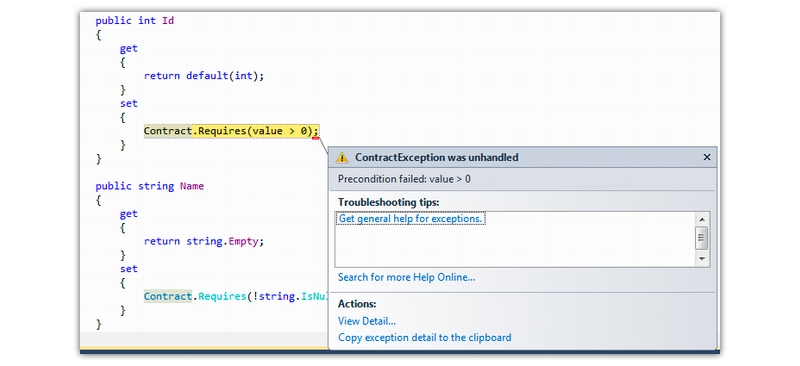
Ans:- Code contracts benefit you to prompt the code expectations and declarations stating the conduct of your code in a language-neutral method. The agreements are comprised in the form of pre-requisites, post-conditions, and object-invariants. The agreements assist you to advance testing by permitting run-time examination, static agreement verification, and certification generation.
Answer: In Server. Transfer page dispensation allocations from one page to the added page deprived of generating a round-trip back to the customer’s browser. This delivers an earlier reply with a slight less above on the server. The customer’s URL history list or present URL Server does not apprise in the case of the Server. Transfer.
Response. Redirect is a rummage sale to readdress the user’s browser to one more page or site. It achieves a trip back to the customer where the customer’s browser is readdressed to the original page
Ans:- All Web pages in ASP.NET are inherited from the Page class. The Page class is a fundamental base class provided by ASP.NET that contains the core functionality and methods for creating web pages. It serves as the foundation for building dynamic and interactive web applications, providing features such as event handling, view state management, and page lifecycle events. By inheriting from the Page class, developers can leverage its functionality and extend it to create custom web pages with specific behaviors and functionalities.
Ans:- The different types of ASP.NET validators present are as follows:

https://images.app.goo.gl/WL3tGGJmLTPKVHC67
Ans:- Yes, ASP.NET is dissimilar from ASP. These are the chief alterations:
Ans:- State management is a method that is needed to accomplish a state of an object on a dissimilar application. It is very significant to accomplish state in somewhat web application. There are dual types of state organization schemes in ASP.NET.
Ans:- Subsequent are the chief alterations among value type and position type:
Ans:- The session object is needed to uphold the session of individually user.
For instance: If a user arrives at the request then he will get a meeting id. If he exits from the request, then the meeting id is removed. If he yet again arrives at the application, he will get a dissimilar meeting id. But in the case of the request object the id is preserved for the entire application.
Ans:- The alteration amid function and stowed procedure:

Ans:- CTS is the constituent of CLR concluded which .NET Framework offers support for numerous languages for the reason that it comprises a type of organization that is shared across all the languages. Binary CTS-compliant languages do not need type adaptation once profession the cipher is written in one philological from inside the code printed in one more language. CTS delivers an improper establishment of data kinds for altogether the languages maintained by.NET Framework.
This implies that the scope of integer and extended variables are similar across all.
NET-compliant software design languages. Though, every language uses aliases for the improper data types offered by CTS. For instance, CTS practices the data type scheme. int32 to signify a 4-byte integer worth; though, Visual Basic practices the identified integer for the equivalent; whereas, C# uses the identified int. This is complete for the sake of clearness and straightforwardness.
Ans:- Side-by-side implementation permits you to run numerous forms of our quest or component and CLR on a similar computer at the identical time. As versioning is appropriate only to collective assemblages and not to isolated assemblies, two requests, one by means of a private assemblage and additional using a collective assemblage, cannot be specified as side-by-side executables.
Ans:- Managed code is the cipher that is implemented straight by the CLR as an alternative to the operating system. The code compiler primarily accumulates the managed code to in-between language (IL) code, likewise named MSIL code. This cipher doesn't be contingent on machine formations and can be implemented on diverse machines.
Unmanaged code is the cipher that is implemented straight by the operating system external to the CLR environment. It is straight amassed to innate machine code which be depending on the machine formation.
In the managed code, meanwhile, the implementation of the code is administered by CLR, and the runtime delivers diverse services, such as trash collection, category checking, exemption handling, and safety support. These facilities help deliver consistency in stage and language-independent behavior of accomplished code requests. In the unmanaged code, the distribution of memory, type security, and safety are compulsory to be taken care of by the designer. If the unmanaged code is not correctly moved, it may consequence in a memory leak. Instances of unmanaged code are located ActiveX mechanisms and Win32 APIs that implement beyond the possibility of natural CLR.
Here are .net interview questions for 5 years of experience or more; these questions will help you understand the horizon of the interviewer and their mindset:
Ans:- NET utilizes the SOLID design principles, which encompass the following:
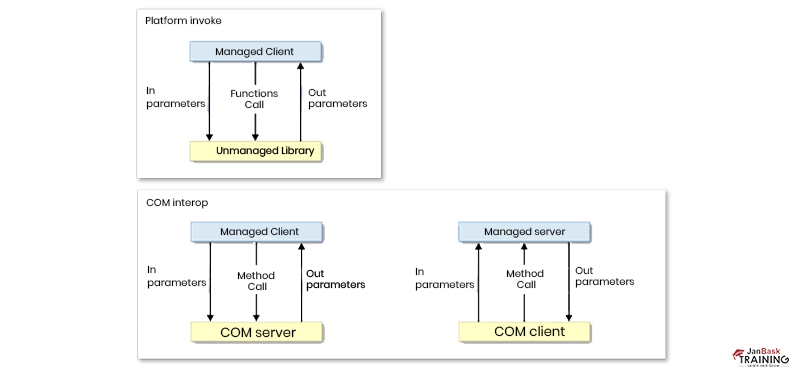
Ans:- Marshaling refers to the process of converting or transforming types between managed and unmanaged code. It enables seamless communication and interaction between different programming environments.
Ans:- Boxing and Unboxing are concepts in C# that allow treating a value of any type as an object. Boxing is the process of converting a value type to an object type. At the same time, unboxing is the reverse process of extracting the value from the boxed object and converting it back to its original value type.
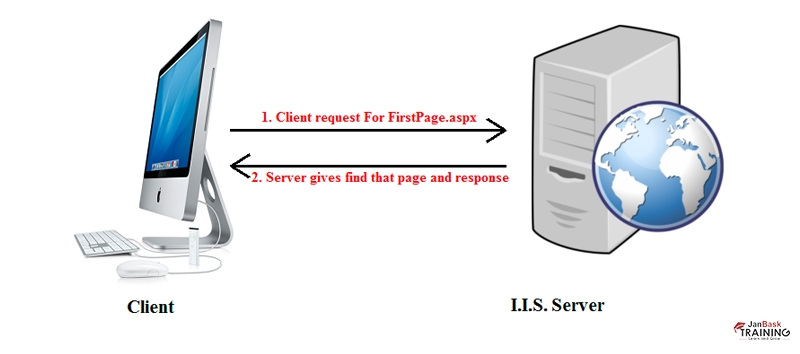
Ans:- Both Server.Transfer and Response. Redirect is used to redirect users from one web page to another. The Response. The redirect method requests a new URL and specifies it in response to the client, resulting in a new page being loaded. In contrast, the Server. The transfer method terminates the execution of the current page and transfers control to a new page on the server side without the client being aware of the change.
Ans:-Garbage Collection in .NET Framework is responsible for automatic memory management. It automatically releases memory space when objects in the heap memory are no longer referenced or in use, thereby preventing memory leaks and improving system performance.
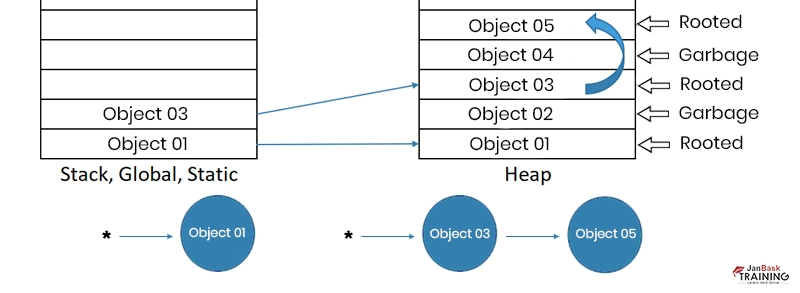
Ans:- The Memory Heap in .NET is divided into three generations: Generation 0: This generation stores short-lived objects. Garbage Collection frequently occurs in this generation. Generation 1: Medium-lived objects are stored in this generation. Generation 2: Long-lived objects reside in this generation.
Ans:- The Debug class calls are included only in Debug mode during application development. They are primarily used for debugging and testing purposes. On the other hand, the Trace class calls are included in both Debug and Release modes, making them suitable for deployment scenarios where you require logging and tracing functionality throughout the application's lifecycle.
Ans:- Debug builds are not optimized and allow for accurate setting of breakpoints. They contain debugging symbols, whereas code built in "Release" mode is optimized for speed or size and does not include debug data.
Ans:-The Application object is employed to share information among all users of an application. It facilitates the organization of ASP files that collaborate to achieve a specific objective. The Application object provides a shared scope for variables and data that must be accessible across multiple users and sessions within the application. Using the Application object, developers can efficiently communicate and share data within the application, enhancing its functionality and user experience.
Ans:- The session object is responsible for storing and retaining information and variables about a user throughout their session. It allows for maintaining state and data persistence during a user's interaction with an application.
Ans:- Managed code runs within the Common Language Runtime (CLR) and requires the installation of the .NET Framework for execution. On the other hand, unmanaged code is not reliant on the CLR and is typically developed using languages outside the .NET framework.
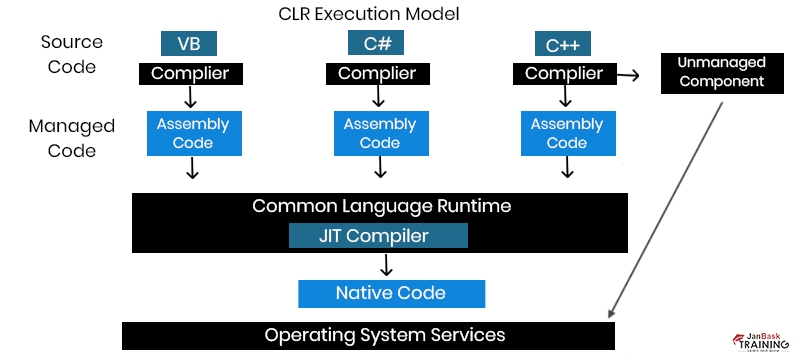
Ans:- The execution of managed code involves the following steps: Choose a language compiler specific to the code language. Convert the code into Intermediate Language (IL) using the compiler. The IL is then targeted to the CLR, transforming it into native code through the Just-In-Time (JIT) compilation process. The computer's processor executes the native code.
Ans:- An Assembly consists of the following components:
i. Manifest: Also referred to as assembly metadata, it contains information about the assembly's version and dependencies.
ii. Type Metadata: Binary information describing the program's types and members.
iii. MSIL: Microsoft Intermediate Language code, which is a low-level, platform-independent representation of the code.
iv. Resources: Related files, such as images or localization files, are embedded within the assembly.
Ans:- MVC, short for Model View Controller, is an architectural pattern for developing .NET applications. It offers a structured approach where the application's logic is divided into three interconnected components: the model, the view, and the controller. MVC provides enhanced control over HTML rendering and is known for its simplicity and ease of use.
Ans:- Functions and Stored Procedures differ in their execution and purpose within a database.
Stored Procedures are pre-compiled database objects that execute a set of instructions when called. They are designed to perform specific actions or tasks within a database, such as data manipulation, complex queries, or business logic operations. Stored Procedures can accept input parameters and return output values, making them useful for modularizing and reusing code.

Ans:- A .NET web service is a component that allows applications to publish their functionalities on the web, making them accessible to the public. It is hosted on a web server and utilizes standard web protocols like HTTP and SOAP (Simple Object Access Protocol) to provide information and services.
Ans:- Web Services offer several advantages, including:
Ans:- MEF stands for Managed Extensibility Framework. It is a library that facilitates the integration of external extensions into host applications seamlessly without the need for additional configuration or setup.
Ans:- Tuples are data structures that allow for the storage of object properties and consist of a sequence of elements with different data types. In .NET Framework 4.0, Tuples were introduced as the Tuple
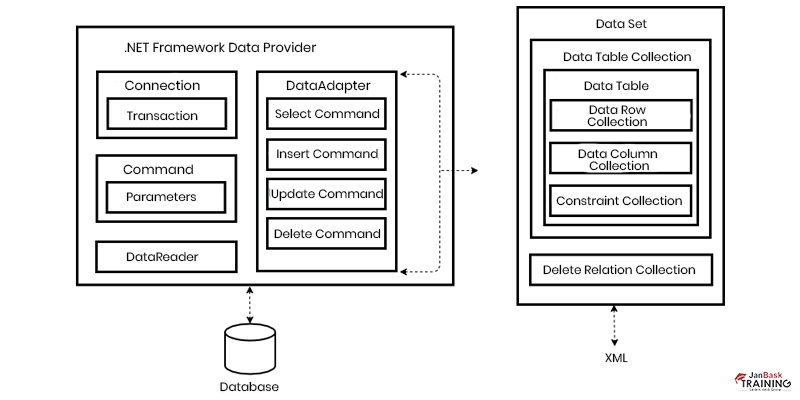
Ans:- ADO stands for ActiveX Data Objects. It is a technology commonly used in Windows application development. ADO provides a means to access relational and non-relational databases using database providers, including Microsoft and other vendors. It serves as an interface for developers to interact with databases and perform data retrieval, modification, and manipulation operations.
Ans:- Net uses the SOLID design principle, which includes the following:
Ans:- Marshaling refers to transforming data between managed and unmanaged code in a .NET application. It allows for seamless communication and interaction between components written in different languages or operating in different memory spaces.
When data is marshaled, it is converted from one representation (such as a managed object) to another representation (such as an unmanaged structure) that the target component can understand.
Ans:- Boxing and Unboxing are concepts in C# that facilitate treating value types as objects and vice versa. Boxing is the process of converting a value type to the corresponding reference type, typically an object. When a value type is boxed, it is wrapped in an object instance, enabling it to be treated as an object and participate in object-oriented features such as inheritance, polymorphism, and passing by reference.
Ans:-These are used to redirect a user from one web page to another. The Response. The redirect method requests a new URL and specifies the new URL. The Server. The transfer method terminates the execution of the current page and starts the execution of a new page.
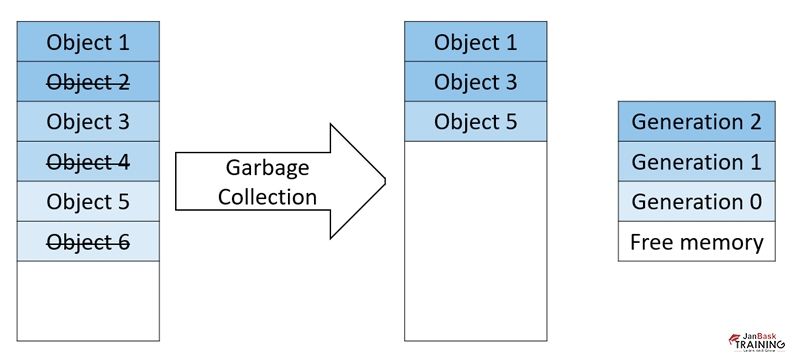
Ans: Garbage Collection in the .NET Framework is an automatic memory management process that helps manage the allocation and deallocation of memory. It relieves developers from explicitly deallocating memory and helps prevent memory leaks. When objects are created in .NET, they are allocated memory in the managed heap.
Ans:-The memory heap is divided into three generations.
Ans:- The call to Debug class is included in Debug mode only and is used during application development. While the call to Trace class will be included in Debug and Release mode, it is used during application deployment.
Ans:- Debug builds, and Release builds are two different configurations of a software project, each serving a distinct purpose. Debug builds are intended for development and testing purposes. They do not optimize the code and allow for the accurate setting of breakpoints and stepping through the code during debugging sessions. Debug builds contain additional debugging symbols and metadata, making it easier to identify issues and analyze the code during debugging.
On the other hand, Release builds are optimized for performance and efficiency in a production environment. They are built with optimizations enabled, resulting in smaller file sizes and faster execution. Release builds do not include debugging symbols or additional debug data, as they are designed to be deployed to end-users without exposing the internal implementation details.
Ans:- The Application object is used in ASP.NET applications to share information among all users of the application. It represents a global scope and can store variables and data that need to be accessible by multiple users and across different sessions. The Application object allows multiple ASP files to work together for a specific purpose, enabling efficient communication and data sharing within the application.

Ans:- The Session object in ASP.NET stores and manages user-specific information during a user's session on a web application. It allows the application to retain user-related data, such as preferences, shopping cart items, or authentication details, throughout the duration of the session. The Session object provides a means to maintain stateful behavior in otherwise stateless HTTP protocol, enabling personalized experiences and data persistence for individual users.
Ans:- Managed code runs inside CLR, and installing the .NET Framework is necessary to execute it. Unmanaged code does not depend on CLR for execution and is developed using languages outside the .NET framework.
Ans:- The steps for executing a managed code are as follows:
Ans:- The different parts of an Assembly are:
i. Manifest: Also known as the assembly metadata, it has information about the version of an assembly.
ii. Type Metadata: Binary information of the program.
iii. MSIL: Microsoft Intermediate Language code.
iv. Resources: List of related files.
Ans:- MVC, which stands for Model View Controller, is an architectural pattern for developing .NET applications. It provides a structured approach to separating the application's logic, user interface, and data into distinct components. In the MVC pattern, the Model represents the data and business logic of the application. It encapsulates the application's data and handles the interaction with the database or other data sources.
Ans:- The main difference between a Function and a Stored Procedure lies in their execution and purpose. Stored Procedures are pre-compiled database objects that contain a set of SQL statements. When called, they are designed to perform specific actions or tasks within a database. Stored Procedures can accept input parameters and return output values. They are primarily used for data manipulation, such as inserting, updating, or deleting records and performing complex queries and data processing operations.
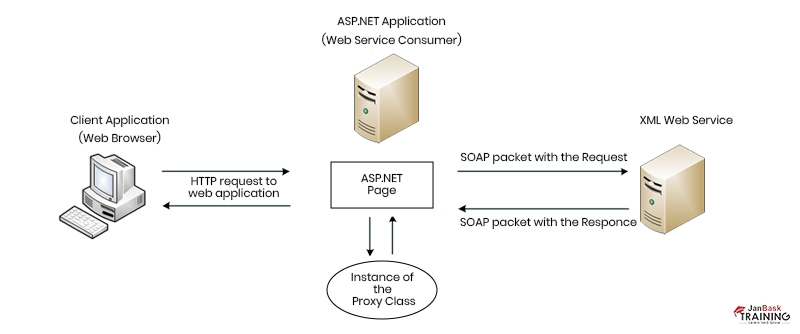
Ans:- It is a component that allows the publishing of the application's function on the web to make it accessible to the public. It resides on a Web server and provides information and services using standard Web protocols such as HTTP and Simple Object Access Protocol (SOAP).
Ans:- Web Services offer several advantages, including:
Overall, the simplicity, extensibility, statelessness, and firewall-friendliness of Web Services contribute to their widespread adoption and effectiveness in building distributed systems.
Ans:- MEF, which stands for Managed Extensibility Framework, is a powerful library in .NET that facilitates the creation of extensible applications. It provides a flexible mechanism for the host application to seamlessly consume and integrate external extensions or plugins. MEF eliminates the need for complex configuration requirements, making it easier to incorporate new functionality into an application dynamically. By using MEF, developers can design applications that can be easily extended and customized without the need for recompilation or modifying the core codebase.
Ans:- Tuples are data structures in .NET that allow you to store a sequence of elements, each of which can have a different data type. Tuples were introduced as a Tuple
Ans:- ADO, which stands for ActiveX Data Objects, is a technology used for data access in Windows applications. It provides a set of programming interfaces that enable developers to access and manipulate data from various sources, including relational and non-relational databases. ADO is an abstraction layer between the application and the database, allowing developers to interact with the data using a consistent and unified approach. ADO supports multiple database providers, including Microsoft's offerings and other third-party providers, making it a versatile solution for data access in Windows applications.
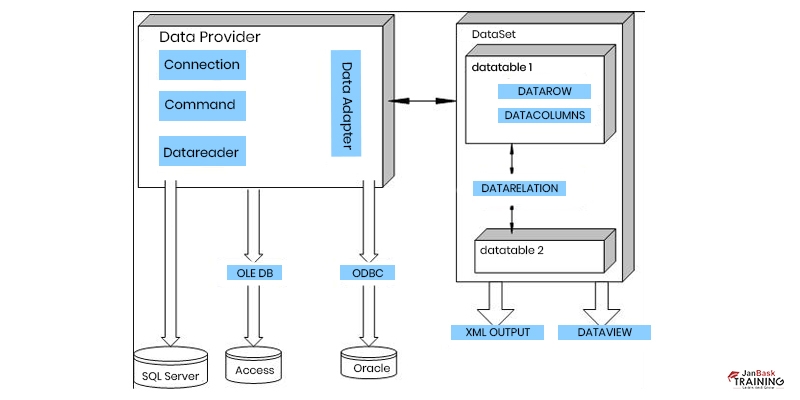
Ans:- Answer: ADO.NET, a data access technology in .NET, involves working with two fundamental objects:
i. DataReader: This object is part of the connected architecture in ADO.NET. It provides fast, forward-only, and read-only access to data from a data source. The DataReader is efficient for retrieving large result sets as it minimizes memory consumption by fetching data stream-likely.
ii. DataSet: This object belongs to the disconnected architecture in ADO.NET. It is a cache-like, in-memory representation of data retrieved from a data source. The DataSet can hold multiple tables, relationships, and constraints. It provides a way to work with data offline, independent of the data source. Changes made to the DataSet can later be reconciled with the data source. These two objects serve distinct purposes in ADO.NET, with the DataReader being suitable for quick and sequential access to data. At the same time, the DataSet provides more flexibility and functionality for working with data disconnectedly.
Ans:- Object Pooling is a concept for optimal use of limited resources through software constructs. The ready-to-use objects, connections, and threads are stored in a pool (group) of objects in memory for later use. For creating a new object, it is pulled from the pool and allocated for the request. Pooling helps in improving performance and facilitates scalability.

Ans:- Client-side validations take place at the client end with the help of JavaScript and VBScript, offering a better user experience. The inputs for client-side validation are validated in the user’s browser. While server-side validations take place at the server end using ASP.Net and PHP, the feedback is sent through a dynamically generated new webpage.

Ans:- Serialization is converting an object's state into a form (a stream of bytes) to be persisted or transported. Deserialization converts a stream into an object and is the opposite of serialization. These processes allow data to be stored and transferred.
Ans:- PE stands for Portable Executable. It is a Microsoft Common Object File Format (COFF) derivative. Windows executable. EXE or DLL files follow the PE file format. It consists of four parts:
1. PE/COFF headers: Contain information regarding. EXE or DLL file.
2. CLR header: Contains information about CLR & memory management.
3. CLR data: Contains metadata of DDLs and MSIL code generated by compilers.
4. Native image section: Contains sections like .data, .rdata, .rsrc, .text, etc.
Ans:- The main difference between DLL (Dynamic Link Library) and EXE (Executable) files lies in their purpose and usage. EXE files are standalone executable files that the operating system can directly execute. They typically represent an application or program that can be run independently. EXE files are intended to be self-contained and often include all the necessary resources and dependencies required for the application to function.
Ans:- Dataset.clone copies only the structure of the DataSet, which includes all DataTable schemas, relations, and constraints, but it does not copy any data. Dataset. copy is a deep copy of the DataSet that duplicates both its structure and data.
Ans:- The ErrorProvider control is used to indicate invalid data or errors to the end-user while filling a data entry form. In case of invalid data entry, the error message attached to the error description string is displayed next to the control.
Ans:- The thread represents an actual OS-level thread, with its own stack and kernel resources, and allows the highest degree of control. You can choose to Abort() or Suspend() or Resume() a thread, and set thread-level properties, like the stack size, apartment state, or culture. While a Task class from the Task Parallel Library is executed by a TaskScheduler to return a result and allows you to find out when it finishes.
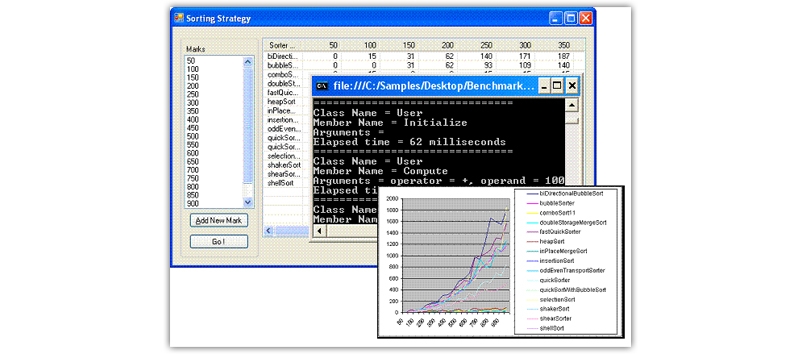
Ans:- .NET is primarily an Object-Oriented Programming (OOP) framework. It emphasizes the principles of OOP, such as encapsulation, inheritance, and polymorphism, to structure and organize code. These concepts are fundamental to designing and developing applications in the .NET framework. While aspects of Aspect-Oriented Programming (AOP) can be achieved in .NET through various frameworks and techniques, the core framework itself primarily supports OOP principles.
Ans:- Multi-threading is a process that contains multiple threads, each performing different activities within a single process. .NET supports multithreading in two ways:
Ans:- No, multiple inheritances are not supported in .NET. This decision was made to avoid the complexities arising from the diamond problem, which occurs when a class inherits from two or more classes with a common base class. Multiple inheritances can lead to ambiguity and conflicts in method and property resolution. Instead of multiple inheritances, .NET promotes the use of interfaces.
Ans:- An ambiguity arises due to multiple inheritances in C#. Two classes B and C inherit from A, and D inherits from both B and C but doesn’t override the method defined in A. The Diamond Problem arises when class B or C has overridden the method differently and D cannot decide to inherit from either B or C.
Ans:- In programming, an interface is a declaration that defines a set of abstract members, including methods, properties, and events. An interface is a declaration for a set of class members. It serves as a contract for classes to implement, specifying the required behavior and functionality.
Ans:- In programming, events are mechanisms that allow classes or objects to notify other classes or objects when a specific action or condition occurs. Delegates, on the other hand, are type-safe function pointers that define the signature of a method. Delegates can be used to subscribe to and handle events in a structured and type-safe manner.
Ans:- Business logic refers to the processing layer of an application that handles the core operations and rules governing the application's functionality. It acts as an intermediary between the user interface layer and the data access layer, ensuring that the application's business rules and processes are implemented correctly. The business logic layer orchestrates the flow of data and operations, making decisions and performing calculations based on the input and desired outcomes.
Ans:- A Component does not draw itself on the form and can be placed below the form area. A control draws itself on the form and can be placed inside the form area. Also, all controls are components, but not all components are controls.
Ans:- User and Custom controls inherit from different levels in the inheritance tree. Custom control is designed for use by a single application while user control can be used by more than one application.
Ans:- Functional requirements are the basic and mandatory facilities that must be incorporated into a system. Non-functional requirements are quality-related attributes that the system must deliver.
Ans:- Reflection objects are used for creating type instances and obtaining type information at runtime. The classes in the System. The reflection namespace gives access to the metadata of a running program.
Ans:- The Global Assembly Cache is a machine-wide code cache that is stored in a folder in the Windows directory. It stores the .NET assemblies that are specifically designated to be shared by all applications executed on the system.
Ans:- Object-Role Modeling (ORM) is a powerful method for designing and querying information systems at the conceptual level. It is an easy and understandable description of the application for non-technical users.
Ans:- Globalization is designing and coding culture-neutral and language-neutral applications. Localization is customizing the application and translating the UI based on specific cultures and regions.
Ans:- MIME stands for Multipurpose Internet Mail Extension. It is an add-on or a supplementary protocol that allows non-ASCII data to be sent through SMTP. It facilitated the exchange of data files on the internet and was proposed by Bell Communications in 1991.
Ans:- The Framework Class Library (FCL) is an integral component of the .NET Framework, consisting of a comprehensive collection of reusable types. These types include classes, interfaces, and data types that provide fundamental functionality for building diverse applications..
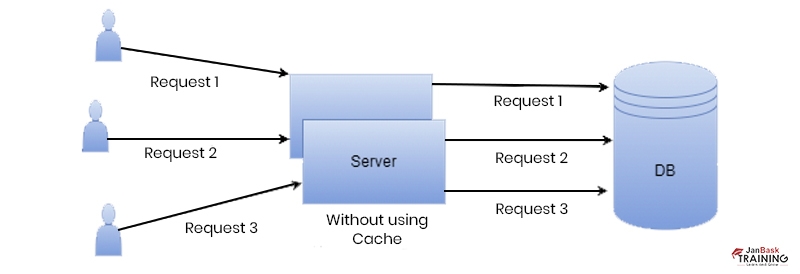
Ans:- Caching plays a crucial role in the .NET Framework by facilitating data storage in memory for efficient and speedy access. It is a technique that temporarily stores frequently accessed data, reducing the need to repeatedly retrieve the data from its original source. The primary purpose of caching is to enhance performance by providing faster access to data.
Ans:- Constants and read-only variables are used to define values that cannot be altered during program execution. However, there are important differences between the two in terms of their usage and behavior. Constants are declared using the const keyword, and their values are set at compile-time. Once assigned, the value of a constant cannot be modified throughout the entire program.
Ans:- In the .NET Framework, types are categorized into two main classifications: value types and reference types. Understanding the differences between these types is crucial when working with .NET applications.
The .NET Framework, created by Microsoft, is a software framework designed for Windows operating systems. It serves as a platform for developing, deploying, and running various types of applications, including desktop and web applications, using .NET technologies.
Whether you are a fresher or an experienced professional, this collection of top .NET interview questions will assist you in refreshing your knowledge and preparing for interviews focused on .NET job roles. Enrolling in our professional certification is a valuable resource to kick-start your preparation and enhance your understanding of the subject matter.
Ans:- The .NET Framework is a software framework developed by Microsoft that provides a runtime environment and a set of libraries for building and running applications. It is essential for developers as it offers a consistent programming model, extensive libraries, and tools that simplify application development, deployment, and maintenance.
Ans:- The key components of the .NET Framework include the Common Language Runtime (CLR), which manages memory, security, and execution of code, and the .NET Class Library, which provides a vast collection of pre-built classes and APIs for various functionalities such as data access, networking, and user interface development.
Ans:- Using the .NET Framework, developers can create a wide range of applications, including desktop applications using Windows Forms or Windows Presentation Foundation (WPF), web applications using ASP.NET, mobile applications using Xamarin, and even cross-platform applications using .NET Core.
Ans:- C# (pronounced "C sharp") is a powerful and versatile programming language used in .NET development. Some advantages of using C# include its simplicity, strong type safety, automatic memory management through garbage collection, support for object-oriented programming principles, and seamless integration with the .NET Framework.
Ans:- The .NET Framework promotes interoperability through its support for Common Language Infrastructure (CLI) standards. It allows developers to write code in multiple languages such as C#, Visual Basic .NET, or F#, which can be compiled into a common intermediate language (IL) that runs on the CLR. Additionally, .NET Core extends this interoperability by enabling cross-platform development for Windows, macOS, and Linux environments.
The JanBask Training Team includes certified professionals and expert writers dedicated to helping learners navigate their career journeys in QA, Cybersecurity, Salesforce, and more. Each article is carefully researched and reviewed to ensure quality and relevance.

Cyber Security

QA

Salesforce

Business Analyst

MS SQL Server

Data Science

DevOps

Hadoop

Python

Artificial Intelligence

Machine Learning

Tableau
Interviews